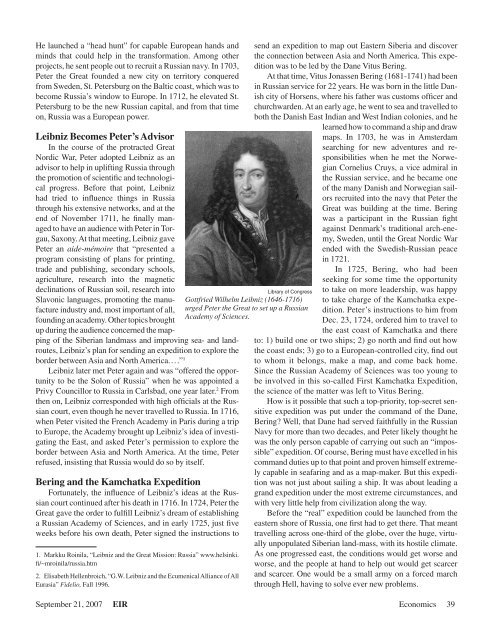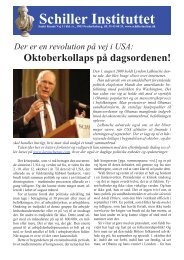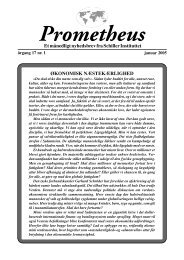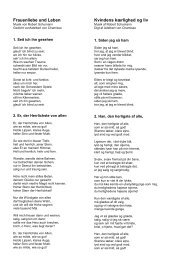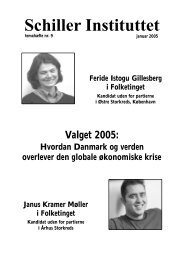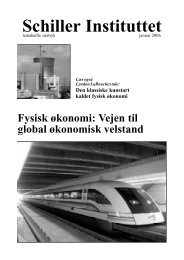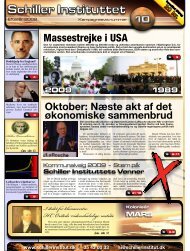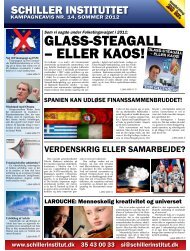Vitus Bering and the Rediscovery of America - schillerinstitut.dk
Vitus Bering and the Rediscovery of America - schillerinstitut.dk
Vitus Bering and the Rediscovery of America - schillerinstitut.dk
You also want an ePaper? Increase the reach of your titles
YUMPU automatically turns print PDFs into web optimized ePapers that Google loves.
He launched a “head hunt” for capable European h<strong>and</strong>s <strong>and</strong><br />
minds that could help in <strong>the</strong> transformation. Among o<strong>the</strong>r<br />
projects, he sent people out to recruit a Russian navy. In 1703,<br />
Peter <strong>the</strong> Great founded a new city on territory conquered<br />
from Sweden, St. Petersburg on <strong>the</strong> Baltic coast, which was to<br />
become Russia’s window to Europe. In 1712, he elevated St.<br />
Petersburg to be <strong>the</strong> new Russian capital, <strong>and</strong> from that time<br />
on, Russia was a European power.<br />
Leibniz Becomes Peter’s Advisor<br />
In <strong>the</strong> course <strong>of</strong> <strong>the</strong> protracted Great<br />
Nordic War, Peter adopted Leibniz as an<br />
advisor to help in uplifting Russia through<br />
<strong>the</strong> promotion <strong>of</strong> scientific <strong>and</strong> technological<br />
progress. Before that point, Leibniz<br />
had tried to influence things in Russia<br />
through his extensive networks, <strong>and</strong> at <strong>the</strong><br />
end <strong>of</strong> November 1711, he finally managed<br />
to have an audience with Peter in Torgau,<br />
Saxony. At that meeting, Leibniz gave<br />
Peter an aide-mémoire that “presented a<br />
program consisting <strong>of</strong> plans for printing,<br />
trade <strong>and</strong> publishing, secondary schools,<br />
agriculture, research into <strong>the</strong> magnetic<br />
declinations <strong>of</strong> Russian soil, research into<br />
Slavonic languages, promoting <strong>the</strong> manufacture<br />
industry <strong>and</strong>, most important <strong>of</strong> all,<br />
founding an academy. O<strong>the</strong>r topics brought<br />
up during <strong>the</strong> audience concerned <strong>the</strong> mapping<br />
<strong>of</strong> <strong>the</strong> Siberian l<strong>and</strong>mass <strong>and</strong> improving sea- <strong>and</strong> l<strong>and</strong>routes,<br />
Leibniz’s plan for sending an expedition to explore <strong>the</strong><br />
border between Asia <strong>and</strong> North <strong>America</strong>. . . .” <br />
Leibniz later met Peter again <strong>and</strong> was “<strong>of</strong>fered <strong>the</strong> opportunity<br />
to be <strong>the</strong> Solon <strong>of</strong> Russia” when he was appointed a<br />
Privy Councillor to Russia in Carlsbad, one year later. From<br />
<strong>the</strong>n on, Leibniz corresponded with high <strong>of</strong>ficials at <strong>the</strong> Russian<br />
court, even though he never travelled to Russia. In 1716,<br />
when Peter visited <strong>the</strong> French Academy in Paris during a trip<br />
to Europe, <strong>the</strong> Academy brought up Leibniz’s idea <strong>of</strong> investigating<br />
<strong>the</strong> East, <strong>and</strong> asked Peter’s permission to explore <strong>the</strong><br />
border between Asia <strong>and</strong> North <strong>America</strong>. At <strong>the</strong> time, Peter<br />
refused, insisting that Russia would do so by itself.<br />
<strong>Bering</strong> <strong>and</strong> <strong>the</strong> Kamchatka Expedition<br />
Fortunately, <strong>the</strong> influence <strong>of</strong> Leibniz’s ideas at <strong>the</strong> Russian<br />
court continued after his death in 1716. In 1724, Peter <strong>the</strong><br />
Great gave <strong>the</strong> order to fulfill Leibniz’s dream <strong>of</strong> establishing<br />
a Russian Academy <strong>of</strong> Sciences, <strong>and</strong> in early 1725, just five<br />
weeks before his own death, Peter signed <strong>the</strong> instructions to<br />
. Markku Roinila, “Leibniz <strong>and</strong> <strong>the</strong> Great Mission: Russia” www.helsinki.<br />
fi/~mroinila/russia.htm<br />
. Elisabeth Hellenbroich, “G.W. Leibniz <strong>and</strong> <strong>the</strong> Ecumenical Alliance <strong>of</strong> All<br />
Eurasia” Fidelio, Fall 1996.<br />
Library <strong>of</strong> Congress<br />
Gottfried Wilhelm Leibniz (1646-1716)<br />
urged Peter <strong>the</strong> Great to set up a Russian<br />
Academy <strong>of</strong> Sciences.<br />
send an expedition to map out Eastern Siberia <strong>and</strong> discover<br />
<strong>the</strong> connection between Asia <strong>and</strong> North <strong>America</strong>. This expedition<br />
was to be led by <strong>the</strong> Dane <strong>Vitus</strong> <strong>Bering</strong>.<br />
At that time, <strong>Vitus</strong> Jonassen <strong>Bering</strong> (1681-1741) had been<br />
in Russian service for 22 years. He was born in <strong>the</strong> little Danish<br />
city <strong>of</strong> Horsens, where his fa<strong>the</strong>r was customs <strong>of</strong>ficer <strong>and</strong><br />
churchwarden. At an early age, he went to sea <strong>and</strong> travelled to<br />
both <strong>the</strong> Danish East Indian <strong>and</strong> West Indian colonies, <strong>and</strong> he<br />
learned how to comm<strong>and</strong> a ship <strong>and</strong> draw<br />
maps. In 1703, he was in Amsterdam<br />
searching for new adventures <strong>and</strong> responsibilities<br />
when he met <strong>the</strong> Norwegian<br />
Cornelius Cruys, a vice admiral in<br />
<strong>the</strong> Russian service, <strong>and</strong> he became one<br />
<strong>of</strong> <strong>the</strong> many Danish <strong>and</strong> Norwegian sailors<br />
recruited into <strong>the</strong> navy that Peter <strong>the</strong><br />
Great was building at <strong>the</strong> time. <strong>Bering</strong><br />
was a participant in <strong>the</strong> Russian fight<br />
against Denmark’s traditional arch-enemy,<br />
Sweden, until <strong>the</strong> Great Nordic War<br />
ended with <strong>the</strong> Swedish-Russian peace<br />
in 1721.<br />
In 1725, <strong>Bering</strong>, who had been<br />
seeking for some time <strong>the</strong> opportunity<br />
to take on more leadership, was happy<br />
to take charge <strong>of</strong> <strong>the</strong> Kamchatka expedition.<br />
Peter’s instructions to him from<br />
Dec. 23, 1724, ordered him to travel to<br />
<strong>the</strong> east coast <strong>of</strong> Kamchatka <strong>and</strong> <strong>the</strong>re<br />
to: 1) build one or two ships; 2) go north <strong>and</strong> find out how<br />
<strong>the</strong> coast ends; 3) go to a European-controlled city, find out<br />
to whom it belongs, make a map, <strong>and</strong> come back home.<br />
Since <strong>the</strong> Russian Academy <strong>of</strong> Sciences was too young to<br />
be involved in this so-called First Kamchatka Expedition,<br />
<strong>the</strong> science <strong>of</strong> <strong>the</strong> matter was left to <strong>Vitus</strong> <strong>Bering</strong>.<br />
How is it possible that such a top-priority, top-secret sensitive<br />
expedition was put under <strong>the</strong> comm<strong>and</strong> <strong>of</strong> <strong>the</strong> Dane,<br />
<strong>Bering</strong>? Well, that Dane had served faithfully in <strong>the</strong> Russian<br />
Navy for more than two decades, <strong>and</strong> Peter likely thought he<br />
was <strong>the</strong> only person capable <strong>of</strong> carrying out such an “impossible”<br />
expedition. Of course, <strong>Bering</strong> must have excelled in his<br />
comm<strong>and</strong> duties up to that point <strong>and</strong> proven himself extremely<br />
capable in seafaring <strong>and</strong> as a map-maker. But this expedition<br />
was not just about sailing a ship. It was about leading a<br />
gr<strong>and</strong> expedition under <strong>the</strong> most extreme circumstances, <strong>and</strong><br />
with very little help from civilization along <strong>the</strong> way.<br />
Before <strong>the</strong> “real” expedition could be launched from <strong>the</strong><br />
eastern shore <strong>of</strong> Russia, one first had to get <strong>the</strong>re. That meant<br />
travelling across one-third <strong>of</strong> <strong>the</strong> globe, over <strong>the</strong> huge, virtually<br />
unpopulated Siberian l<strong>and</strong>-mass, with its hostile climate.<br />
As one progressed east, <strong>the</strong> conditions would get worse <strong>and</strong><br />
worse, <strong>and</strong> <strong>the</strong> people at h<strong>and</strong> to help out would get scarcer<br />
<strong>and</strong> scarcer. One would be a small army on a forced march<br />
through Hell, having to solve ever new problems.<br />
September 21, 2007 EIR Economics 39


